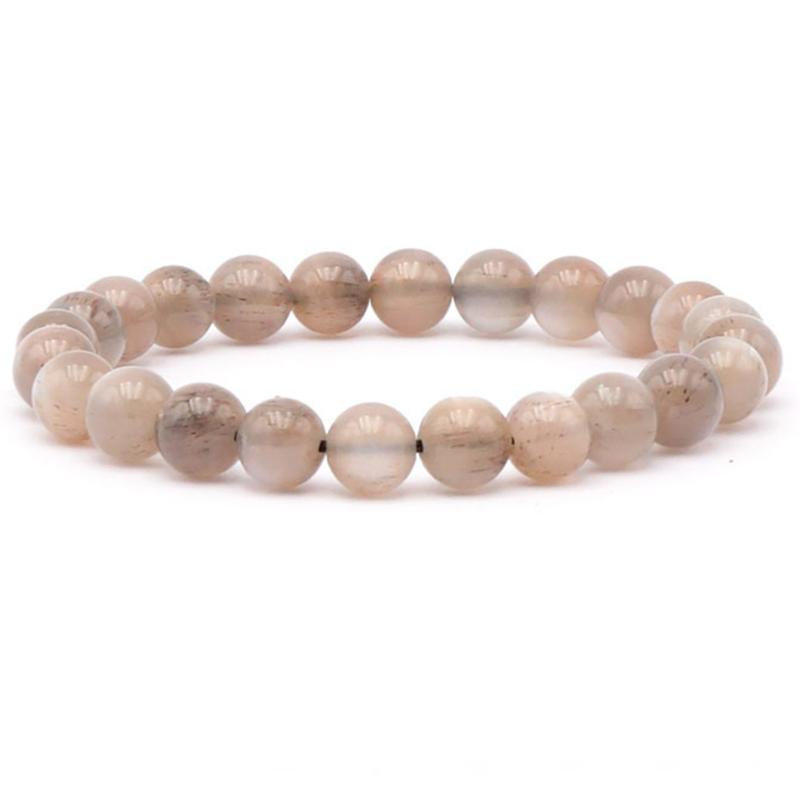Gray moonstone bracelet India AA+ (7.5-8.5mm balls)
BRA-PDL-66
- Regular price
-
26,90 € - Regular price
-
26,90 € - Sale price
-
26,90 €
Couldn't load pickup availability
Learn more
BRA-PDL-66
Origin: India
Grade: AA+
Dimensions:
About 18cm. Suitable for all wrists from 17 to 19cm.
Weight:
About 25g
Elastic bracelet composed of 7.5-8.5mm balls of gray moonstone.
Colors and patterns may vary from one stone to another.
The origin of the name moonstone comes from distant civilizations who named stones based on their natural appearance or physical characteristics.
Moonstone was named so because of its striking resemblance to the moon. This stone has a soft color with pearly reflections similar to the moon.
In ancient times, there was a belief that moonstone was actually pieces of solidified moon that arrived on earth. However, this name moonstone is a purely commercial name.
The scientific name of this stone is adularia. Indeed, during the 18th century, an important deposit of this adular stone was found at Mount Adula, located on the border between Switzerland and Italy. Today, this deposit is unfortunately exhausted.
Moonstone is also called Hecatolite in homage to Hecate, goddess of the Moon in Greek mythology.
No matter what name we give to this stone, it maintains a close link with the moon, which gives it many virtues.
Whatever the civilizations, the Moon and the Sun are stars that have always fascinated our ancestors. The latter lent celestial power to moonstones.
It has been shown that lunar cycles play an important role on the environment, the Earth, the seas. They also have an influence on men's moods, including sleep disturbances.
In ancient times, the Greeks worshiped moonstone, which they named hecatolite stone after Hecate, their moon goddess. They gave him many offerings hoping to receive the power of clairvoyance and protection. This stone was the symbol of fertility and passion. Worn by pregnant women, this stone protected their pregnancy.
In ancient Rome, femininity and the gift of clairvoyance were associated with moonstone. At the same time, this stone represented Diana, goddess of the moon and animals. She had the power to change friendly feelings into loving feelings. She also protected couples.
The Indians were convinced that moonstone was a stone that had absorbed a lot of lunar rays. There is another version which explains that the moonstone is in fact a fragment of the moon that fell to earth. Today, in India, this pearly stone is still sacred.
In the Middle Ages, this moonstone greatly appealed to women who attributed to it the power to increase fertility and maintain passion. Subsequently, this stone protected the pregnant woman and her fetus during pregnancy.
In Egypt, night travelers wore a moonstone pendant to protect them from possible attacks and to fight against evil spirits.
In 1970, the moonstone became the official emblem of Florida in honor of the Kennedy Space Center, the launch site of the Apollo 11 rocket for the first time to the moon in 1969.
The stone is a mineral which belongs to the silicate group and which is of the feldspar family. Its hardness is 6 to 6.5 on the Mohs scale. Which makes it a perfect stone for jewelry making. This mineral presents different colors, beige, pink, gray, black, with this pearly appearance and the phenomenon of adulescence (shimmering under the surface of the stone with reflection of light between the layers of the stone).
The main deposits are located in India, Madagascar, Australia, China, the United States, Sri Lanka, etc.
Gray moonstone can be from a very light gray to a darker gray with an iridescent appearance and bluish reflections. This stone is commonly used in jewelry making. It sometimes happens that it is confused with labradorite jewelry. This stone has properties similar to white moonstone and blue moonstone.
It is attributed with mystical virtues. Furthermore, it is nicknamed Stone of the New Moon. It is the stone of choice for mediums, shamans, etc. Gray moonstone was very successful during the Art Nouveau period. Furthermore, we found its trace in Roman jewelry in the year 100 AD.
In India, gray moonstone was a traditional wedding gift. She protected this union from disputes. Furthermore, this stone was supposed to reconcile separated lovers. Since the beginning of time, a gray moonstone has been placed on the forehead of the Indian moon goddess, Chandra.
Gray moonstone is a stone that develops relationships on a personal and professional level. The wearer of this stone displays qualities of listening and understanding towards others.
This stone is also known for its many intuitive and emotional properties. It allows you to feel love and peace. It is a stone that encourages the person to release their emotions and to open up to others. The feelings that have been repressed will be able to manifest in a positive way.
Gray moonstone is a stone of protection against negative energies. In addition, it naturally helps the development of compassion, tenderness and forgiveness.
This stone is relatively recommended for leaders, people who occupy leadership or management positions or for coaches. It engenders their empathy in order to demonstrate more understanding with the people they lead.
Gray moonstone brings to the surface buried memories or fears that are often the cause of psychological blockages. It allows you to move forward and overcome life's difficulties. It is a stabilizing stone of life.


Gray moonstone bracelet India AA+ (7.5-8.5mm balls)
- Regular price
-
26,90 € - Regular price
-
26,90 € - Sale price
-
26,90 €
-
100% SECURE PAYMENT
Paypal, credit card, check, transfer
-
FREE DELIVERY
from 40€ purchase
-
SATISFIED OR REFUNDED
14 days to change your mind
-
CUSTOMER SERVICE AVAILABLE
contact@laboiteacailloux.com
to receive all our offers, good deals and new products from La Boite à Cailloux


